Fifteen years after the end of World War II, William L. Shirer published his epic book, The Rise and Fall of the Third Reich. I purchased the book almost forty years ago through the “Book of the Month Club”⏤remember that organization? (Believe it or not, BOMC still exists.) I just finished reading it and there were many topics from ninety-years ago that pertain to today’s world. Today’s blog captures one of those subjects.
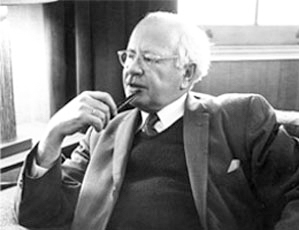
William L. Shirer (1904−1993) was an American journalist and war correspondent. He was an eyewitness to the rise of Adolf Hitler and Nazism during the 1930s. He started as a print journalist and worked for Universal Service until 1937 when he was fired from the William Randolph Hearst news company. Edward R. Murrow, European manager for CBS, immediately hired Shirer to open a bureau on the European continent. (Murrow worked out of the London office and wanted a correspondent located in Europe.) Shirer’s office was in Vienna but most of his reporting was done onsite from Paris, Berlin, and Rome. After Dunkirk, he personally followed behind the movement of German troops to report on the war. As the Nazis continued to pressure him in 1940 to report inaccurate information, Shirer suggested to Murrow that his tenure in Nazi territory was about over. Right about the same time, Shirer learned the Gestapo was developing a case against him for espionage which carried the death penalty. In December 1940, Shirer left Germany and did not return to Europe until 1945 when he covered the Nuremberg trials.
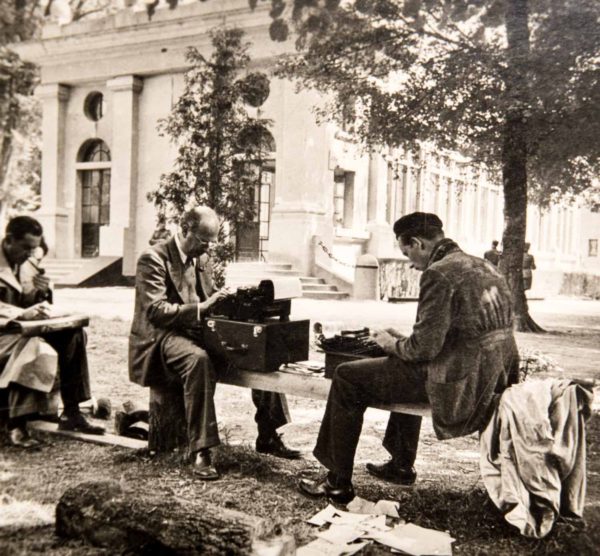
Did You Know?
Did you know how we all came to say “Roger that” to confirm a message? It is a typical response used in the military but for us baby boomers, we can remember the CB radios and truckers using “Roger that” to make sure the person on the other end knew the message had been received. The phonetic alphabet (e.g., Alpha, Bravo, Charlie, etc.) once used “Robert” for the letter R. That was replaced with “Roger” (and subsequently replaced with “Romeo”). During morse code days, confirmation was indicated by typing “R” meaning “Roger.” So, when World War II came along and the two-way radios were used, soldiers used the verbal acknowledgement, “Roger that” as their way of confirming the message.
Roger that?
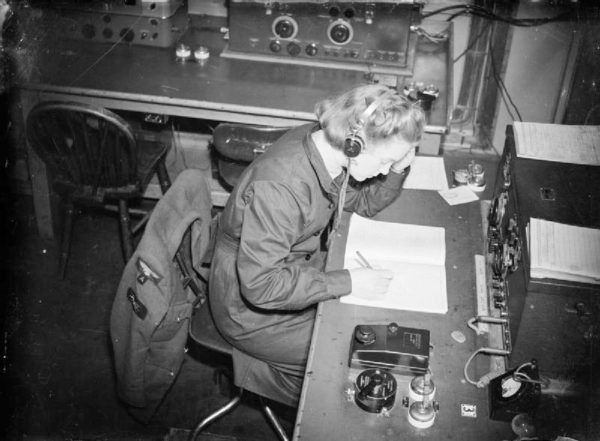
Today, we will explore the specific events leading to the outbreak of war in Europe on 1 September 1939. You will see that Hitler had a “play book” that he followed in most every instance in dealing with Britain and other countries regarding appeasement and his insatiable appetite for conquest. As we know, Hitler was a pathological liar. His tactics during the first years were to talk and promise peace, secretly prepare for war, and rearm Germany in a clandestine manner to avoid military action by the Versailles Powers (e.g., France and Great Britain). As Shirer points out, Hitler’s 1925 book, Mein Kampf (“My Fight” or “My Struggle”) was a manifesto of ideas including the reunion of Austria and Germany and a belief that the Kaiser’s biggest mistake was becoming an enemy of England with the desire to match Britain’s naval power. The book was a point-by-point guidebook to Hitler’s future aggressive actions including his intentions toward Jews and other Nazi Untermensch. It seems no one outside Germany ever read the book.
The Austrian Putsch–1934
“Germany neither intends nor wishes to interfere in the internal affairs of Austria, to annex Austria, or to conclude an Anschluss.”
⏤Adolf Hitler
“Peace” speech to the Reichstag
21 May 1935
Hitler authorized the assassination of the fascist Austrian chancellor, Engelbert Dollfuss (1892−1934)⏤Dollfuss had banned the Nazi party in Austria⏤and on 25 July 1934, members of the Austrian Nazi party shot Dollfuss through the throat. However, the attempted coup was thwarted by Austrian government officials and order was restored. Kurt von Schuschnigg (1897−1977) was appointed temporary chancellor. Like the Beer Hall putsch in 1923, this coup was premature, but it sent a message.
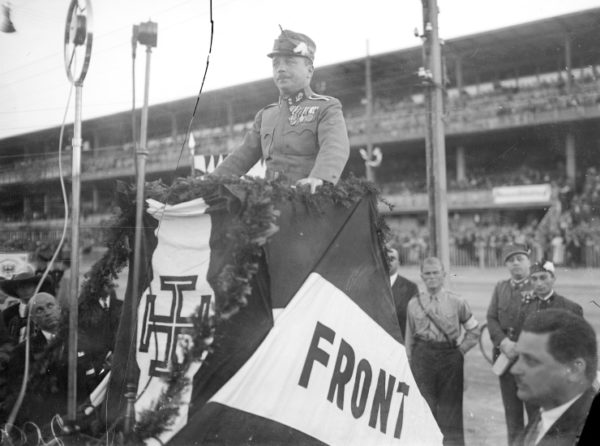
The Saar Basin–1935
Under the terms of the Treaty of Versailles, the industrialized Saar Basin (or Saar Valley) was to be occupied by Britain and France. On 13 January 1935, the citizens of the Saar voted overwhelmingly to return their coal-rich territory to the Reich. Afterward, Hitler proclaimed to the world that Germany had no territorial claims on either France or Britain.
The Rhineland–1936
On 7 March 1936, several divisions of German troops crossed the Rhine bridge and entered the Demilitarized Zone located in the Rhineland (“Operation Schulung”). This was in violation of the 1919 Treaty of Versailles and later, the 1925 Locarno Treaty. Hitler’s excuse for the invasion was that France had signed a pact with the Soviet Union which invalidated the Locarno Treaty. The Reichsminister of Foreign Affairs, Konstantin von Neurath (1873−1956), informed Britain and France that Germany had taken possession of the Rhineland and promptly delivered Hitler’s peace proposal. (In other words, take action and then ask for forgiveness.) During the 48-hours after Schulung, senior Nazis were very worried that the British and French would send in their armies. It was Hitler’s first real bold military maneuver, and his army would have been greatly outnumbered and likely defeated if the Versailles Powers had enforced the terms of the treaties (and probably result in the demise of Hitler as well). The British commented that, “The Germans, after all, are only going into their own back garden.” The success of Schulung cemented Hitler’s popularity with the Germans and convinced them that Hitler could achieve his goals without going to war. (By the fall of 1936, senior German military officers knew better.) The other outcome of Schulung was that Hitler became convinced the international community had no stomach to resist him.
Click here to watch the video clip Germany Marches Into The Rhineland 1936.
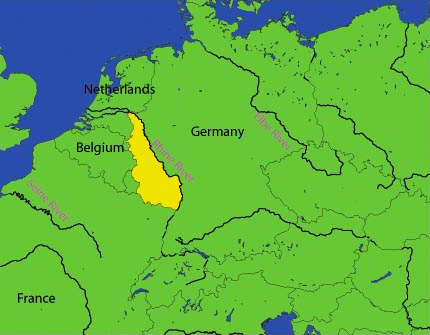
The Anschluss–The Rape of Austria–March 1938
Throughout 1937, the Austrian Nazi party practiced its own brand of terror. Supported by Berlin, the Austrian Nazis bombed, participated in violent demonstrations, and made plans to assassinate Schuschnigg. In January 1938, the Austrian government raided the Nazis’ headquarters in Vienna. There they found documents indicating the Austrian Nazis were going to stage a revolt in the spring and after Schuschnigg intervened, Germany would invade Austria on the pretext of preventing “German blood from being shed.” Hitler fired his top diplomats and senior military advisors (i.e., Franz von Papan, Konstantin von Neurath, Werner von Fritsch, and Werner von Blomberg) in part for trying to convince the Führer not to go to war because Germany was not ready. This sent the message to the German military leaders and others that Hitler was preparing to invade Austria followed by a world war.
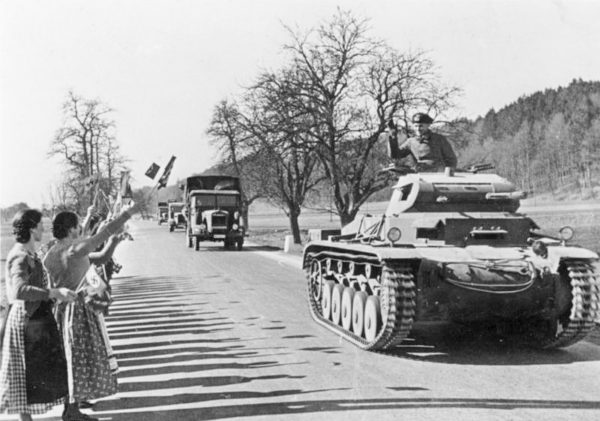
Schuschnigg wasn’t as naïve as the British or French. He knew what Hitler was up to. On 12 February 1938, Schuschnigg met with Hitler at Berchtesgarden. The meeting was dominated by an angry, shouting, and accusatory Führer. He told Schuschnigg that the “Austrian problem would be solved one way or the other.” Hitler threatened Schuschnigg over what he saw as Austria’s belligerence toward Germany. After lunch, Schuschnigg was presented with an agreement drawn up by Hitler and told these were Germany’s final demands and were to be signed immediately without any discussion. Schuschnigg knew that to sign it, he would sacrifice Austria’s independence. After intense pressure from Hitler and his senior staff, Schuschnigg signed the document and sealed his country’s fate.
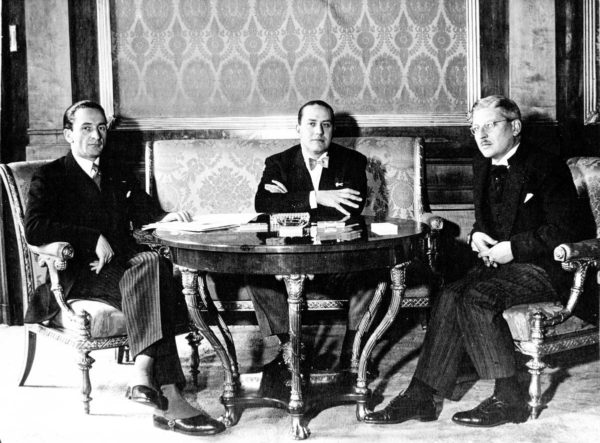
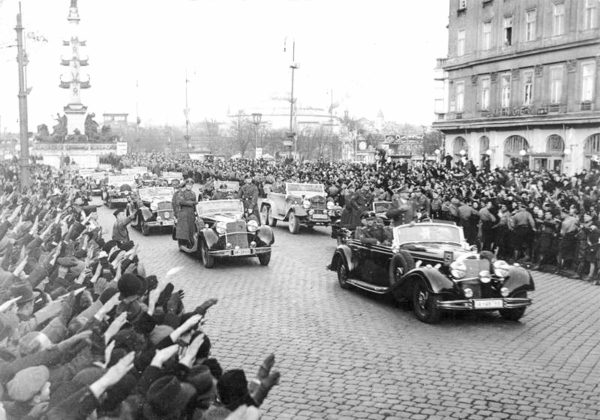
On 16 February, the Austrian government ordered a general amnesty for the Austrian Nazi party. The cabinet was reorganized and Arthur Seyss-Inquart was named minister of security. In a speech on 20 February to the Reichstag, Hitler warned he would protect the rights of seven million Germans in Austria and three million Sudeten Germans in Czechoslovakia. It did not seem the British or French picked up on this. Soon, Seyss-Inquart began taking over all aspects of the Austrian government, including the police. On 10 March, Hitler surprised his generals with his decision to occupy Austria. The following day, Hitler issued Directive Number One (“Operation Otto”)⏤the orders for the military to invade Austria. The reason he gave was that Schuschnigg did not carry out the terms of the agreement and the German people living in Austria had the right to decide their own fate. The Germans marched in and by 5:30 p.m., Schuschnigg had resigned. The following day, Schuschnigg was arrested and taken to Gestapo headquarters. He spent the remainder of the war in KZ Sachsenhausen and KZ Dachau.
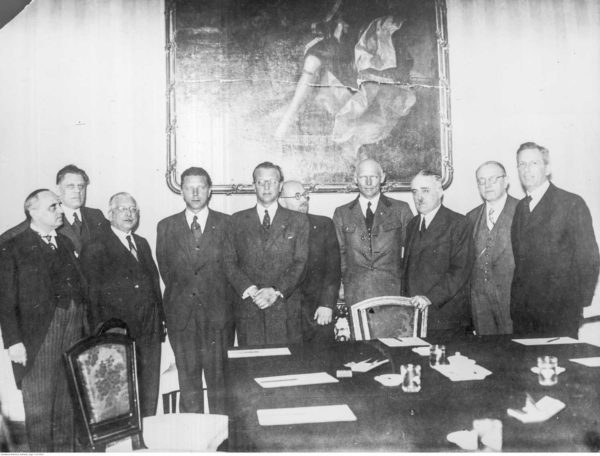
As far as the reaction of the British, his majesty’s government “registered a protest in the strongest of terms” and then did nothing. One more time, Hitler proved the Versailles Powers would not stop his aggression.
Click here to watch the video clip German Troops March Into Austria 1938.
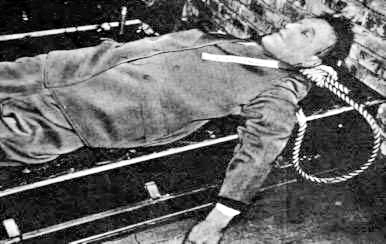
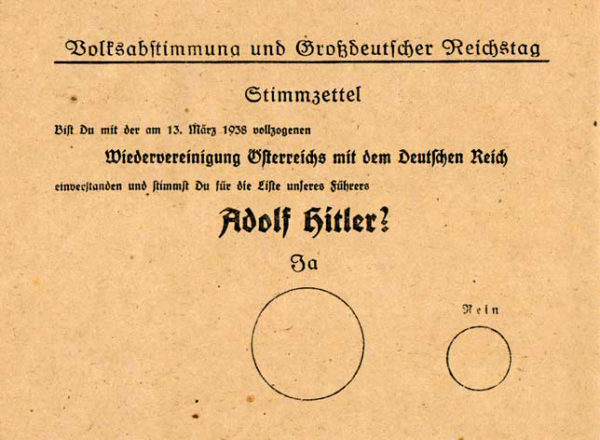
“Peace In Our Time”–September 1938
“How horrible, fantastic, incredible it is that we should be digging trenches and trying on gas masks here because of a quarrel in a far-away country between people of whom we know nothing.”
⏤Neville Chamberlain
British prime minister
27 September 1938
“Code Green” was Hitler’s directive for the surprise attack on Czechoslovakia⏤the plan had been drawn up in June 1937. Now it was time for the three million Sudeten Germans to be “protected” by Hitler. The Sudeten Nazis followed the same script as the Austrian Nazis had a year earlier. Hitler decided to follow the same playbook as he had in the past⏤military “action after a period of diplomatic discussions which gradually lead to a crisis and to war.”
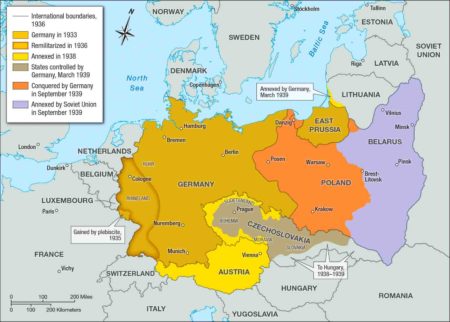
France and Britain tried to get Czechoslovakia to accept the German demand for autonomy of the Sudeten. The Czechs refused and began to mobilize their military. This prompted Hitler to send 750,000 troops to the German-Czechoslovakia border. Britain’s prime minister, Neville Chamberlain (1869−1940), flew to Germany on 15 September 1938 to tell the Führer that England would accept Sudeten self-government. The Czechoslovakia president was told by the British and the French that he must agree to the German demands.
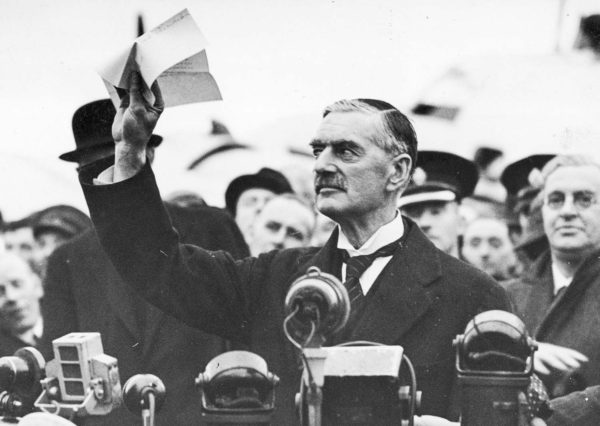
On 22 September, Chamberlain flew back to Germany for a second meeting with Hitler. At this meeting, Hitler upped the ante. He was now demanding that Czechoslovakia be broken up. Although Hitler finally backed off that new demand, he set deadlines for the cession of the Sudetenland. The Czechs refused and France mobilized its army while England mobilized its navy.
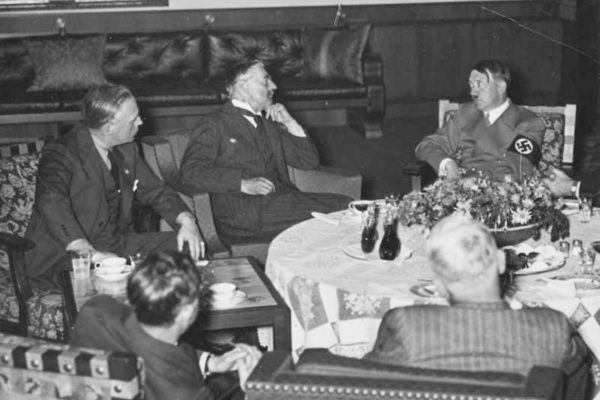
At the eleventh hour, a frenzied series of telegrams and phone calls were made between the leaders of Italy, France, Britain, and Germany. Just before Hitler’s ultimatum deadline, he invited Chamberlain, Daladier (France), and Mussolini (Italy) to meet with him in Munich. Czechoslovakia was not represented during any of the discussions. Shortly after midnight on 30 September, the Munich Agreement was signed. It allowed the German army to march into Czechoslovakia on 1 October and occupy the Sudetenland. A map of the new borders was handed to a waiting representative of the Czech government and told his government was responsible for evacuating the areas ceded to the Germans. Chamberlain returned to England with “Peace in Our Time.” Unfortunately, it only lasted less than one year.
Click here to watch the video clip The Munich Agreement–September 30, 1938.
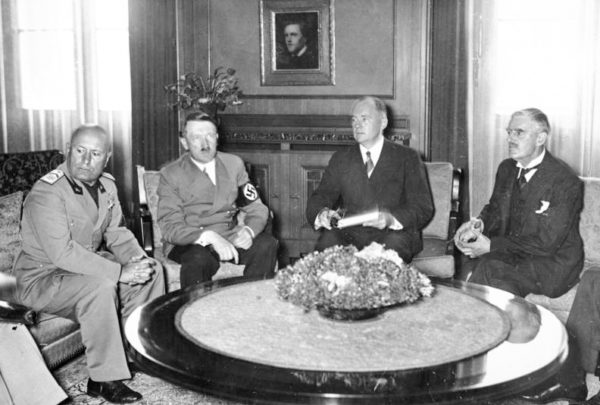
Poland–September 1939
Now it was Poland’s turn. However, there were no real discussions or “negotiations” conducted in good faith (at least from the German side of the table) with the Polish government. Hitler had decided on a surprise attack. However, the Polish border was secure and would not be easy to penetrate. Hitler also knew that if Britain and France threw their military at him, his troops would be overwhelmed. There was also the little problem that England and France had treaties with Poland whereby they would go to war if Poland was attacked but based on prior acts of aggression by the Nazis, the Führer was not convinced anyone would stand up for Poland. What he didn’t know was that one year after the Munich Agreement, Chamberlain and others finally had figured out Hitler’s game plan and they were beginning to show some backbone.
So, Hitler needed two things for this military action to be successful in addition to his normal political “excuse” for invasion. First, he had to have a concrete reason whereby Germans are threatened and need protection. That was easy as we will see. Second, Hitler knew that he couldn’t just walk in unless he made a deal with his mortal enemy, the Soviet Union and its dictator.
The city of Danzig was the pawn used for Hitler’s political excuse. He demanded Poland turn the city over to the Germany. Poland was willing to negotiate on other terms, but they flatly refused to cede Danzig to the Nazis. This wasn’t the first time a smaller nation had said “no” to the German dictator and he used it to threaten the Poles with aggression if Polish troops violated Danzig territory (presumably the German minority in Danzig would need to be protected).
In May 1939, the Soviet Union and Germany began talking about working together on mutually beneficial economic issues. At the same time, Stalin was playing a double game with his overtures to Britain. Late May saw Hitler and his advisors chew on whether to approach Stalin for a non-aggression pact. This would have two effects: blunt any Russian alliance with Britain and allow Germany to invade Poland without any negative consequence from the Soviets. Stalin distrusted England and France and felt they might make a deal with Hitler. So, after a lot of negotiating and nail biting on the part of the Germans, the Soviets agreed in mid-May to sign what became known as the Molotov-Ribbentrop pact, or the German-Soviet Non-Aggression Pact. (After Hitler had agreed to all of the Soviet demands.) It included the partitioning of Poland and a secret agreement concerning a joint guarantee of the Baltic States. (In other words, Stalin could invade without any retaliation from Germany.)
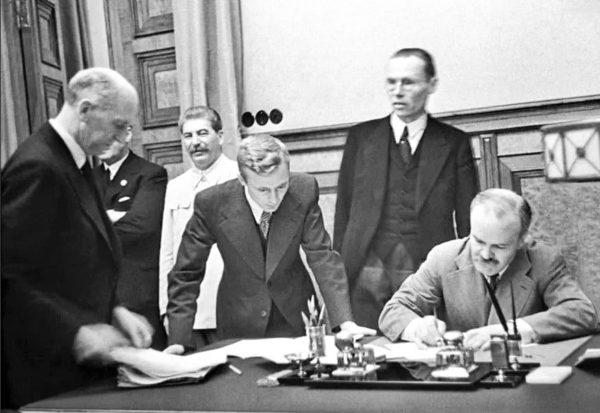
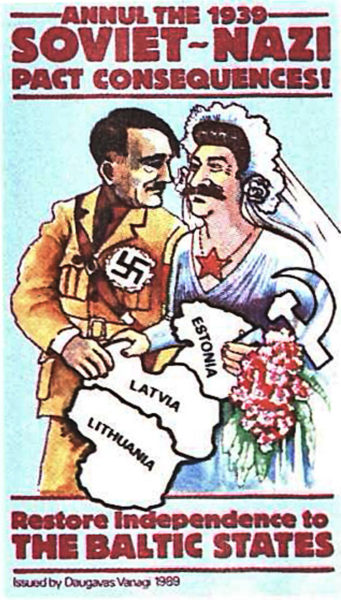
Now, all Hitler needed was the third piece; an incident that provides the necessary excuse for the Germans to retaliate in “self-defense.” Within two weeks of signing the Soviet non-aggression pact, Hitler gave the orders to initiate “Case White,” the invasion of Poland on 1 September. (Up until that point, Hitler was continuing the charade of trying to negotiate with Poland and making noise that he wanted peace.) The manufactured incident occurred on the border with a simulated Polish attack on a German radio station located at Gleiwitz. The SS provided inmates from the concentration camps to “act” as German casualties⏤they were drugged and shot by SS men dressed in Polish army uniforms. The Polish “attacks” on German civilians was enough to unleash the Wehrmacht which had been standing by at the border.
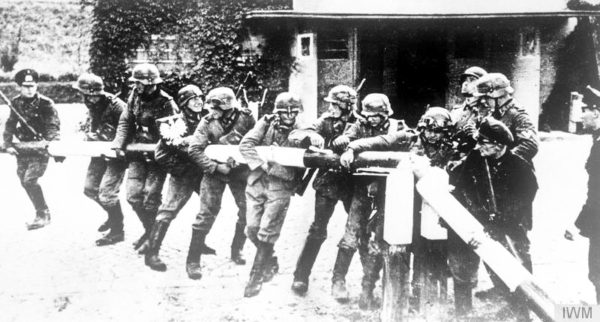
Two days later, Britain declared war on Germany and World War II was launched.
Click here to watch the video clip Warsaw Surrenders 1939.
Abridged Version
This is a severely paired down version of these events. I suggest reading William Shirer’s books for a much more detailed story. His written account is based on being a personal witness to the events as well as documents released as part of the Nuremberg trials or defendants’ testimonies given at the trials. It is a fascinating “behind the scenes” account of Hitler’s aggressions and the lack of response by the Versailles Powers. Shirer points out the many opportunities Britain and France had to challenge Hitler and support an overthrow of the German dictator.
It was interesting to read how Hitler handled the negotiations of these events. As you read Shirer’s account (and admittedly, not as disjointed as my short blog), it becomes clear that Hitler always used the same tactics to bully his opponents. As I read on, I could not help but put this into perspective of today’s world events. We see China maneuvering in Hong Kong, Taiwan, and the South China Sea. Russia is making claims on the Ukraine. Political shifts in the Middle East occur daily.
History is repeated. Becoming familiar with these events leading to World War II and in particular, the political positioning (both public and behind closed doors) can lead to a better understanding of contemporary events.
★ ★ ★ Learn More About The Rise of The Third Reich ★ ★ ★
Shirer, William L. Berlin Diary: An Inside Account of Nazi Germany 1934−1941. New York: Bonanza Books, 1984 (original edition: 1941).
Shirer, William L. The Nightmare Years 1930−1940. Boston: Little, Brown and Company, 1984.
Shirer, William L. The Rise and Fall of the Third Reich. New York: Simon and Schuster, 1960.
Wick, Steve. The Long Night: William Shirer and The Rise and Fall of the Third Reich. New York: Palgrave MacMillan, 2011.
Disclaimer:
There may be a chance that after we publish this particular blog, the video links associated with the blog are no longer accessible. We have no control over this. Many times, whoever posts the video has done so without the consent of the video’s owner. In some cases, it is likely that the content is deemed unsuitable by YouTube. We apologize if you have tried to access the link and you don’t get the expected results.
What’s New With Sandy and Stew?
As many of our friends know, our seventh planned book in the series on Paris history was to be Where Did They Bury Jim Morrison, the Lizard King? A Walking Tour of Curious Paris Cemeteries. It was to be published after the second volume of the Nazi occupation book.
Well, we’ve changed our minds. Our seventh book will stay on the subject of World War II. However, we will leave Paris and venture off to Berlin. After studying the city’s layout, public transportation system, and potential sites to visit, we will develop a walking tour of Berlin. The working title for the book will be Where Did They Put the Führerbunker? A Walking Tour of Nazi Berlin (1933−1945). Once that book is completed, we will return to Paris for the cemetery book.
If you have an opinion or comments about our new “game plan,” please let me know. I’d like to hear your thoughts, especially from those of you familiar with Berlin.
Thank you to all of you who subscribe to our bi-weekly blogs. It seems there isn’t a day that goes by where we don’t increase our readership. Please let your history buff friends and family members know about our blog site and blogs.
Someone Is Commenting On Our Blogs
I’d like to thank Michael P. for his comments after reading our blog, Agent Jack, “M” and the Fifth Column (click here to read the blog). Michael pointed out there was a fifth column in Wales and a government double cross operation (click here to read The Double Cross System). He recommended a book, The Welsh Double Cross by John Humphries. I’m looking forward to doing some research into this⏤perhaps a future blog topic?
If there is a topic you’d like to see a blog written about, please don’t hesitate to contact me. I love hearing from you so keep those comments coming.
Why Would You Want to Buy Our Walking Through History Books?
Simple.
You like to travel and experience history and historical events. You like to see original buildings that had a significant impact on the people and events of the history you’re engaged with. You want to know the stories behind the brick and mortar in front of you.
The walking tour books are meticulously researched so you can go directly to those sites and learn about the building’s history as well as an introduction to some of the more interesting people associated with it.
We Need Your Help
Please tell your friends about our blog site and encourage them to visit and subscribe. Sandy and I are trying to increase our audience and we need your help through your friends and social media followers.
Thank You
Sandy and I appreciate you visiting with us. We have some exciting things on the horizon, and we’ll keep you updated as we go along.
Share This:
Follow Stew:
Find Stew’s books on Amazon and iBooks.
Please note that we do not and will not take compensation from individuals or companies mentioned or promoted in the blogs.
 Walks Through History
Walks Through History
Copyright © 2021 Stew Ross


Stew and Nancy
I agree with your decision on the publishing sequence on the Berlin book….Sehr gut und richtig! After the American TV series “Hitler Alive” and “In the Garden of Beasts”, your book will be a good primer for visiting Berlin. I just read your blog on the Rhineland resulting in me downloading one of Schier’s first books on Germany. Thank you!
Hi Patrick. It’s good to hear from you again. Thanks for confirming our decision to be the right one. After deciding to go to Berlin, it wasn’t hard to figure out that book should come after the two volumes on the occupation of Paris. You will enjoy William Shirer’s books, regardless of which one you pick to read. Hope to hear from you again soon. STEW and SANDY.
After reading this article, I could not help but reminisce about the book :
“Rise and Fall of the Third Reich”.
I bought it in 1966 and just like you I had a problem reading it ! It was so detailed that I got lost and put it aside. A few years later I tried again but having kids around did not give me enough time to concentrate and I let it go until I found it a few years ago and … donated it.
It took you 40 yrs to read it and it took me 40 yrs to ditch it !
Hi Nicole; good to hear from you! Thanks for sharing the story of the book you purchased fifty-five years ago. I didn’t get around to reading it because frankly, I just didn’t have the time nor was I involved with researching and writing the blogs and books. Now that I have set time aside each day to read, I decided to give it a try. It’s a fascinating book and so well written. I’m looking forward to reading some of his other books. It’s too bad Shirer is not alive today to take advantage of all the declassified documents. Take care and I think we are getting closer to being able to schedule a trip to Paris. STEW
Who said ““action after a period of diplomatic discussions which gradually lead to a crisis and to war”
Thanks Cooper for contacting us. I believe I picked up that quote from William L. Shirer’s book, “The Rise and Fall of the Third Reich.” Let me know if you have any other questions. STEW
Map of Germany with the Sudetenland highlighted in red. Photo and art by 52 Pickup, Feldgrau (October 2012). PD-CCA-Share Alike 3.0 Unported. Wikimedia Commons.
*************************************
Definitely wrong. I don’t have time to check what part of Germany (or France) have you highlighted in red but for sure it was not the area known as Sudetenland. Sudetenland was the strip of land in Czechoslovakia bordering the Germany, it means on the eastern side of Germany. Not on the western, as it was wrongly shown in your picture.
Hi Steven; Thank you for contacting us. Yes, you are absolutely correct. The caption incorrectly identifies the Sudetenland on the map image. Stuff like this doesn’t usually get through our multiple edits and reviews but this time, it did. I appreciate you pointing it out and we will get the image replaced with a correct map. Thanks again for letting us know. If you run across any other issues with future (or past) blogs, please don’t hesitate to let me know. STEW